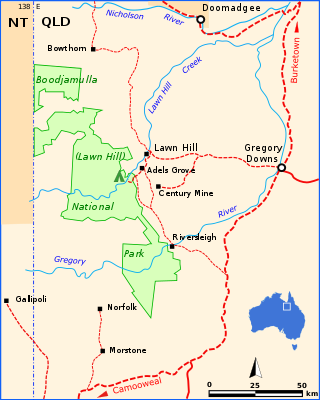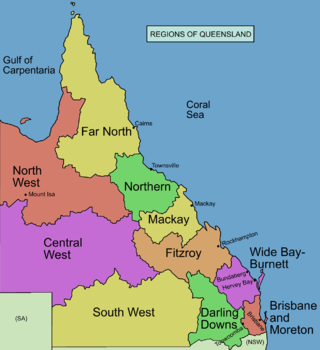Notes and references
Notes
- ↑ Trigger 2015, p. 56.
- ↑ Roberts 2009, p. n.52.
- ↑ Headon 1988, p. 30.
- ↑ Roberts 2005, pp. 121, 274–275.
- ↑ Evans 2007, p. 137.
- ↑ Sutton 2004, p. 5.
- ↑ Palmer, K. (2018). Australian Native Title Anthropology: Strategic practice, the law and the state. JSTOR Open Access monographs. ANU Press. p. 277. ISBN 978-1-76046-188-1 . Retrieved 30 October 2020.
- ↑ "Information Service: Queensland: Extinguishment by pastoral lease". AMPLA Bulletin . 14 (2). Australian Mining and Petroleum Law Association): 90.
Related Research Articles

Boodjamulla National Park, formerly known as Lawn Hill National Park, is a national park in the Shire of Burke, Queensland, Australia. The Riversleigh World Heritage Area is a World Heritage Site within the park.
Doomadgee is a town and a locality in the Aboriginal Shire of Doomadgee, Queensland, Australia. It is a mostly Indigenous community, situated about 140 kilometres (87 mi) from the Northern Territory border, and 93 kilometres (58 mi) west of Burketown.

The Aboriginal Shire of Doomadgee is a special local government area in North West Queensland, Queensland, Australia. It is managed under a Deed of Grant in Trust under the Local Government Act 2004.

The Gulf Country or North West Queensland is the region of woodland and savanna grassland surrounding the Gulf of Carpentaria in north western Queensland and eastern Northern Territory on the north coast of Australia. The region is also called the Gulf Savannah. The Gulf Country is crossed by the Savannah Way highway.
Umpila, also known as Ompeila, Ompela, Oom-billa, or Koko-umpilo, is an Aboriginal Australian language, or dialect cluster, of the Cape York Peninsula in northern Queensland. It is spoken by about 100 Aboriginal people, many of them elderly.
Waanyi, also spelt Wanyi, Wanji or Waanji, is an endangered Australian Aboriginal language spoken by the Waanyi people of the lower gulf area of Northern Queensland, Australia. Although earlier thought to be extinct, as of the 2016 Australian census there were 16 speakers of the language. This was down from the recorded peak of 40 in the 2011 Australian census.

The Gugu Badhun are an Aboriginal nation whose country is located in the Upper Burdekin region of northern Queensland. Gugu Badhun country is approximately 220 km northwest of Townsville and includes the small township of Greenvale as well as a number of pastoral stations. The most comprehensive and up-to-date description of the nation is found in the book Gugu Badhun: People of the Valley of Lagoons, published in 2017.
The Lardil people, who prefer to be known as Kunhanaamendaa, are an Aboriginal Australian people and the traditional custodians of Mornington Island in the Wellesley Islands chain in the Gulf of Carpentaria, Queensland.
The Nguburinji people, also written Ngoborindi, Oborindi and other variations, are an Aboriginal Australian people whose traditional lands lie in northwest Queensland.
The Waanyi people, also spelt Wanyi, Wanji, or Waanji, are an Aboriginal Australian people from south of the Gulf of Carpentaria in Queensland and the Northern Territory.
The Garrwa people, also spelt Karawa and Garawa, are an Aboriginal Australian people living in the Northern Territory, whose traditional lands extended from east of the McArthur River at Borroloola to Doomadgee and the Nicholson River in Queensland.
The Yanyuwa people, also spelt Yanuwa, Yanyula and other variations, are an Aboriginal Australian people of the Northern Territory who live in the coastal region inclusive of and opposite to the Sir Edward Pellew Group of Islands in the southern Gulf of Carpentaria.
The Warndarrang people, (waɳʈaraŋ), also spelt Warndarang, Wanderang, and other variants were a predominantly coastal Aboriginal Australian people of eastern Northern Territory. Though extinct as a distinct ethnolinguistic group, their descendants survive among the neighbouring Nunggubuyu.
The Yukul, also written Jukul, were an indigenous Australian people of the Northern Territory.
The Yukulta people, also spelt Jokula, Jukula, and other variants, and also known as Ganggalidda or Gangalidda, are an Aboriginal Australian people of the state of Queensland.
The Mingin, also known as the Mingginda, are an Aboriginal Australian people of the state of Queensland, who lived in the Gulf Country east of Moonlight Creek and the Yukulta / Ganggalidda people in the southern Gulf of Carpentaria.
The Kukatj are an Aboriginal Australian people of the Cape York Peninsula in the state of Queensland. They are to be distinguished from the Kukatja of Western Australia and the Luritja of the Northern Territory, who have also historically been known as Kukatja.
Margaret Clare Sharpe is a linguist of Australian Aboriginal languages, specializing in Yugambeh-Bundjalung languages, with particular regard to Yugambir, She has also done important salvage fieldwork on the Northern Territory Alawa language.

John Watson was a frontier cattle station manager, drover, and murderer in the British colony of Queensland and in the Northern Territory. He was renowned for his fearless behaviour and also his sadistic brutality toward Indigenous Australians. He was called "The Gulf Hero" due to much of his fame being achieved while working on pastoral properties located in the Gulf Country.
The Koonchera Point massacre was an attack by colonial police on Aboriginal Australians that took place at Mindiri Hole near Lake Howitt in far north South Australia in the 1880s. Part of the Australian frontier wars, sources indicate that it resulted in the deaths of between 200 and 500 Ngameni, Yawarrawarrka, Yandruwandha and Bugadji people. The event that led to the attack was the killing and eating of a bullock by Aboriginal people. The massacre was unreported by the police, but one of the five survivors related what occurred to an Arabana elder, and in 1971 he reported it to the linguist Luise Hercus. The elder described the massacre as "the end of the Mindiri people".
References
- Evans, Raymond (2007). A History of Queensland. Cambridge University Press. ISBN 978-0-521-87692-6.
- Headon, David (1988). "'The Coming of the Dingos' - Black/White Interaction in the Literature of the Northern Territory". In Nelson, Emmanuel Sampath (ed.). Connections: Essays on Black Literatures. Aboriginal Studies Press. pp. 25–39. ISBN 9780855751869.
- Roberts, Tony (2005). Frontier Justice: A History of the Gulf Country to 1900. University of Queensland Press. ISBN 978-0-702-24083-6.
- Roberts, Tony (November 2009). The Brutal Truth: What Happened in the Gulf Country. The Monthly.
- Sutton, Peter (2004). Native Title in Australia: An Ethnographic Perspective. Cambridge University Press. ISBN 978-1-139-44949-6.
- Trigger, David (2015). "Change and Succession in Aboriginal Claims to Land". In Toner, P.G. (ed.). Strings of Connectedness: Essays in honour of Ian Keen. Australian National University Press. pp. 53–73. ISBN 978-1-925-02263-6.